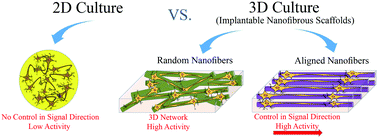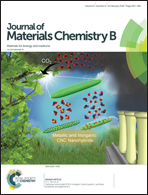Influence of topography of nanofibrous scaffolds on functionality of engineered neural tissue†
Abstract
Properly engineered scaffolds combined with functional neurons can be instrumental for the effective repair of the neural tissue. In particular, it is essential to investigate how three-dimensional (3D) systems and topographical features can impact on neuronal activity to obtain engineered functional neural tissues. In this study, polyphenylene sulfone (PPSu) scaffolds constituted by randomly distributed or aligned electrospun nanofibers were fabricated to evaluate the neural activity in 3D culture environments for the first time. The obtained results demonstrated that the nanofibers can successfully support the adhesion and growth of neural stem cells (NSCs) and enhance neuronal differentiation compared to 2D substrates. In addition, NSCs could spread and migrate along the aligned fibers. The percentage of active NSC-derived neurons and the overall network activity in the fibrous substrates were also remarkably enhanced. Finally, the data of neuronal activity showed not only that the neurons cultured on the nanofibers are part of a functional network, but also that their activity increases, and the direction of neural signals can be controlled in the aligned 3D scaffolds.



 Please wait while we load your content...
Please wait while we load your content...